Wages in the Nonprofit Sector: Management, Professional, and Administrative Support Occupations
Originally Posted: October 28, 2008 The National Compensation Survey now publishes wage data on full-time workers in private nonprofit establishments. This is the first in a series of three articles comparing the average hourly earnings of full-time workers in private nonprofits, private industry as a whole, State governments, and local governments. In 2007, there were more than 1.64 million nonprofit organizations in the United States.1 The nonprofit sector has expanded in terms of number of organizations and number of paid employees. In 1994, there were more than 1.1 million nonprofit organizations in the United States,2 employing about 5.4 million people, or 4.4 percent of all workers. By 2007, nonprofits employed 8.7 million workers, or 5.9 percent of all workers.3 Health professionals, educators, other professionals, health technicians, administrative support workers, and service occupations account for the majority of paid workers in the nonprofit sector.4 Considering the growth of the nonprofit sector, it is interesting to compare the wage rates of workers in nonprofits with those of their counterparts in private industry as a whole5 and in State and local government. The National Compensation Survey (NCS) provides a source of recent data for making this comparison. Separate wage estimates for full-time workers in private nonprofit establishments were published in the annual wage publication National Compensation Survey: Occupational Earnings in the United States, 2007.6 The NCS now provides average hourly wage estimates for full-time workers employed in all private industry, the private nonprofit sector, State government, and local government by occupational group and by detailed occupation.7 There are several hypotheses as to why the wages of nonprofit workers could differ from their for-profit counterparts. According to the labor donation hypothesis, workers in the nonprofit sector are willing to donate a portion of their paid labor and receive lower wages because they obtain satisfaction from the fact that their efforts achieve altruistic goals. Also, nonprofits may pay lower wages and compensate their workers with employer-provided benefits or other favorable job characteristics such as a flexible work schedule. On the other hand, nonprofits might actually pay higher wages because nonprofits do not benefit from the cost reductions of paying lower wages in the same way that for-profit employers do. In addition, nonprofits may choose to hire better quality workers in order to produce a better quality product or service and pay these employees higher wages.8 This article compares the wages of management, selected professional, and administrative support workers in nonprofit organizations with those of their counterparts9 in private industry as a whole, State government, and local government. Management, selected professional, and administrative support occupations are found in many industries, working in support of an organization’s main function.10 Because their skills are needed in a wide range of organizations, their wages are discussed in this first article of a three-part series. The second article in the series will look at the wages of workers in occupations concentrated in schools and research institutions; and the third article will examine the wages of occupations concentrated in health care and social assistance organizations. Nonprofit organizationsThe term nonprofit refers to organizations that are neither for-profit businesses nor government agencies. Nonprofits are a subset of private industry. Nonprofit organizations may generate revenue, but this revenue cannot be distributed to owners or employees as they might be in a for-profit business. Nonprofits include, but are not limited to, hospitals, churches, educational institutions, social welfare organizations, and charitable organizations. More than one million charitable organizations11 work to benefit a variety of different causes, such as disaster relief, civil rights, community development, environmental advocacy, and the arts. Charitable organizations also include hospitals and private schools. More than half of all hospitals12 and almost a third of postsecondary educational institutions13 are nonprofit. Social welfare organizations14 are similar to charitable organizations, yet they differ in several ways. For example, social welfare organizations are permitted to participate in some lobbying and political campaign activities, while charitable organizations are not. Programs offered by nonprofits may supplement those provided by government agencies and for-profit businesses. There are also programs that are created, overseen, and funded by State or Federal government (or both) but administered by nonprofits. These government-nonprofit partnerships have contributed to the growth of the nonprofit sector.15 All full-time workersAs can be seen in chart 1, the average hourly earnings of full-time workers in nonprofits were $21.68 in 2007. This was somewhat greater than the average hourly wages of all full-time private industry workers ($21.08). However, nonprofit workers earned less than State government workers ($23.77 per hour) and local government workers ($25.16 per hour).16 It should be noted that such wage differences might be due in part to differences in occupational composition among the sectors. 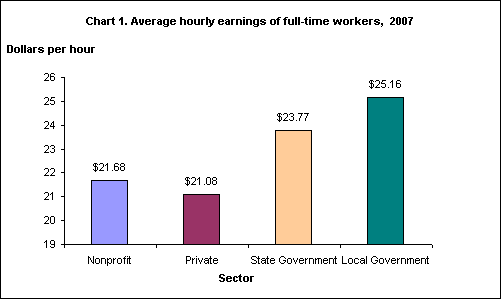 Previous studies that compare the wages of nonprofit and for-profit workers have found somewhat similar results. For example, a 2001 article by Laura Leete examined data from the 1990 census and found a slightly positive wage differential for full-time nonprofit workers.17 In a 2003 article, Christopher J. Ruhm and Carey Borkoski used data from the Current Population Survey and concluded that the wages of workers in nonprofits were approximately the same as those at for-profits.18 Management occupationsManagers perform duties such as planning, directing, and coordinating the daily operations of establishments; they also are generally involved in the financial and budgetary aspects of the business. The management occupational group includes CEOs and top-level managers, as well as managers of individual functions, such as sales and human resources. Compensation for managers of nonprofit organizations is monitored by the Internal Revenue Service (IRS), which can impose intermediate sanctions, or excise taxes, if it finds the compensation of a tax-exempt organization’s executives to be "unreasonable." For public companies, the Sarbanes-Oxley Act of 200219 requires an increase in the disclosure of executive compensation. As chart 2 shows, the average hourly earnings of managers in private establishments ($41.38) were greater than those in nonprofit establishments. Managers in nonprofits averaged $34.24 per hour, less than managers in local government ($39.75 per hour), but not significantly less than managers in State government ($36.18 per hour). 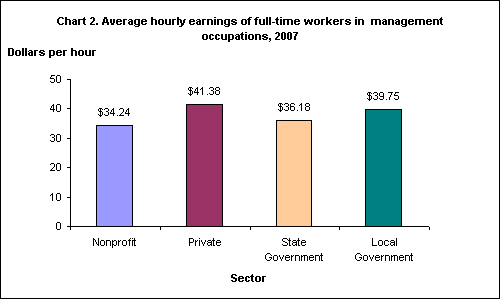 In examining the wages of specific occupations within the management occupations group, some statistically significant differences were found. For example, the average hourly earnings of human resources managers at nonprofits ($40.35) were higher than those of their counterparts in State governments ($28.65). A statistically significant difference was also found among social and community service managers, with those in local governments earning $32.07 per hour, compared with $25.07 per hour for those in nonprofits. Business and financial operations occupationsChart 3 shows that, as a group, business and financial operations occupations at nonprofit establishments earned $26.49 per hour, significantly more than their counterparts in State government ($23.16 per hour), but not significantly less than these occupations in local government ($26.79 per hour). Wages of business and financial workers were the greatest in private industry, with an average of $29.57 per hour.  Within the business and financial workers group, there was no significant difference found in the average hourly wages of accountants and auditors in private industry ($27.83 per hour), nonprofits ($25.25 per hour), and local governments ($26.03 per hour). The average hourly wages of accountants and auditors in State governments were $23.29; these workers earned less than their counterparts in private industry and local government, but not significantly less than those in nonprofits. Computer and mathematical science occupationsAs desktop computers and electronic communications have become widespread in the workplace, full-time workers to support these technologies have also become more prevalent. These workers may be employed by the establishment or they might be private contractors.20 As chart 4 shows, computer and mathematical science occupations in private establishments averaged $35.09 per hour, which is significantly more than the wages of those employed by nonprofits ($32.00 per hour). The wages of nonprofit computer and mathematical science workers were higher than those of State government workers ($26.87 per hour) and local government workers ($28.25 per hour). 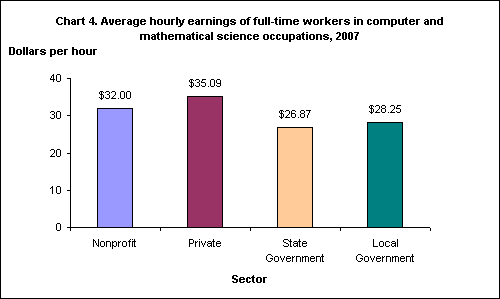 Legal occupationsLegal occupations include lawyers, paralegals, and magistrates. Lawyers are found in private for-profit and nonprofit entities, as well as in State and local government as public prosecutors and public defenders. Chart 5 shows the average hourly earnings of legal occupations at nonprofits ($33.53), private establishments ($39.23), State government ($38.14), and local government ($28.99). The differences were not statistically significant. Lawyers averaged $40.50 per hour at nonprofits, which was similar to those in State and local governments ($38.36 per hour).21 Lawyers in private industry earned the most, averaging $54.69 per hour. (These data are for wage-and-salary workers only; earnings of lawyers who are self-employed, owners, or partners in unincorporated firms are not included in the NCS.) 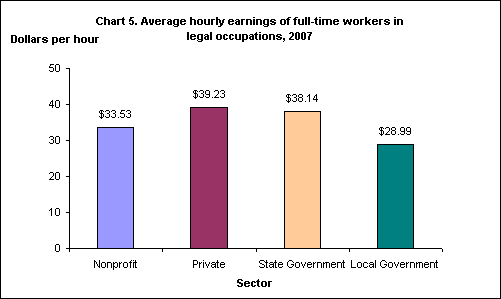 Office and administrative support occupationsOffice and administrative support occupations include secretaries and administrative assistants as well as tellers, dispatchers, and various types of clerks. Chart 6 shows the wages of these workers in the various sectors. Office and administrative support workers at local governments averaged $16.76 per hour, which is significantly more than the wages of these workers at nonprofit establishments ($15.46 per hour). The average hourly wages of nonprofit office and administrative support workers were similar for State government workers ($15.92) and private industry workers ($15.65). Secretaries and administrative assistants had higher hourly earnings in private industry ($18.39) and local government ($17.76) than in nonprofits ($16.40). However, the hourly earnings of secretaries and administrative assistants in State government ($17.11) were not significantly higher than those in nonprofits. 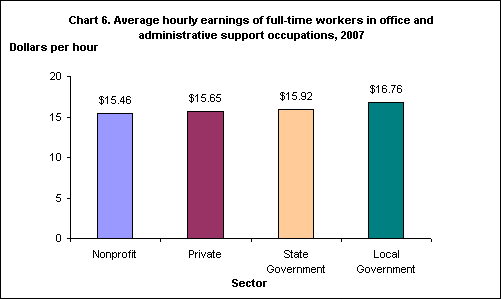 SummaryUsing 2007 National Compensation Survey data to compare the wages of full-time workers in nonprofit organizations, all private industry, State government, and local government organizations, the following results were found:
Notes1 Data on the number of tax-exempt organizations are from Internal Revenue Service Data Book 2007, Publication 55B (Internal Revenue Service, March 2008), table 25; available on the Internet at http://www.irs.gov/taxstats/article/0,,id=168593,00.html. Note that churches are not required to apply for tax-exempt status. 2 Internal Revenue Service Data Book 1997, Publication 55B (Internal Revenue Service), table 27; available on the Internet, at: http://www.irs.gov/taxstats/article/0,,id=97216,00.html. 3 Unpublished data from the Current Population Survey (CPS), 1994 and 2007 annual averages of the total number of full-time nonagricultural private wage and salary workers employed at nonprofit organizations. Note that 1994 was the first year the CPS collected private nonprofit employment data. 4 Christopher J. Ruhm and Carey Borkoski, "Compensation in the Nonprofit Sector," The Journal of Human Resources, autumn 2003, pp. 992-1021. 5 Private industry includes both nonprofit and for-profit establishments. Wage estimates for employees of for-profit establishments are not available. 6 National Compensation Survey: Occupational Earnings in the United States, 2007, Bulletin 2704 (Bureau of Labor Statistics, August 2008); available on the Internet at http://www.bls.gov/ncs/ncswage2007.htm. The National Compensation Survey (NCS) has always included nonprofit establishments in its private industry measures of occupational earnings, compensation cost trends, benefit incidence, and detailed benefits provisions. For more information on the National Compensation Survey, see the BLS Handbook of Methods, Chapter 8, available on the Internet at http://www.bls.gov/opub/hom/homtoc.htm. 7 Occupations are classified according to the 2000 Standard Occupational Classification (SOC) system, which categorizes more than 800 individual occupations into 23 major groups. The National Compensation Survey does not survey agriculture, Federal government, military, or private household employers. For more information on the detailed occupations included in each major occupational group, see National Compensation Survey: Occupational Earnings in the United States, 2007, appendix B; available on the Internet at http://www.bls.gov/ncs/ocs/sp/ncbl0841.pdf. 8 Christopher J. Ruhm and Carey Borkoski, "Compensation in the Nonprofit Sector," The Journal of Human Resources, autumn 2003, pp. 992-1021; Laura Leete, "Whither the Nonprofit Wage Differential? Estimates from the 1990 Census," Journal of Labor Economics, January 2001, pp. 136-170. 9 That is, those workers who are classified in the same occupations according to the 2000 Standard Occupational Classification (SOC) system. 10 Data on employment by industry and occupation are available from the BLS Occupational Employment Statistics program; available on the Internet at http://www.bls.gov/oes/. 11 Charitable organizations are classified under section 501(c)(3) of the Internal Revenue Code. 12 In 2005, of the 5,756 hospitals in the United States, 2,958 were nongovernmental and nonprofit. Statistical Abstract of the United States: 2008 (U.S. Census Bureau), table 163; available on the Internet at http://www.census.gov/compendia/statab/index.html. 13 For the 2006-07 period, 1,640 of a total of 4,314 degree-granting institutions were nonprofit and 208 of 2,222 non-degree-granting Title IV institutions offering postsecondary education were nonprofit. Digest of Education Statistics: 2007 (National Center for Education Statistics), tables 255 and 359; available on the Internet at http://nces.ed.gov/programs/digest/. 14 Social welfare organizations are classified under section 501(c)(4) of the Internal Revenue Code. 15 Lester M. Salamon, ed., The State of Nonprofit America (Washington, D.C., Brookings Institution Press, 2002). 16 Statements of comparisons in this article are significant at a standard error level of 1.645 or more (90-percent confidence level), unless indicated otherwise. See table 1 for wage estimates and the corresponding relative standard errors for selected full-time management, professional, and administrative support occupations in 2007. 17 Leete, "Whither the Nonprofit Wage Differential? Estimates from the 1990 Census," Journal of Labor Economics. 18 Ruhm and Borkoski, "Compensation in the Nonprofit Sector," The Journal of Human Resources. 19 The Public Company Accounting Reform and Investor Protection Act of 2002 is commonly referred to as the Sarbanes-Oxley Act. 20 NCS does not survey individuals who are self-employed and does not include contractors in establishments receiving their services. NCS does survey contracting establishments, and the wages of contracted workers are collected at the establishment that employs them, not at the establishment where they are working at the time. 21 Combined wage estimate for State and local government workers.
|
Tools |
Calculators |
Help |
Info |